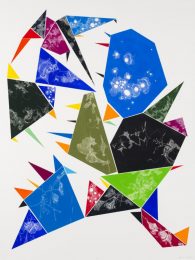

The Qualities Of Carborundum Prints
Carborundum is a versatile abrasive material that artists sometimes use in printmaking, specifically in a technique known as Carborundum printmaking.
The primary reasons why artists use Carborundum in printmaking include:
Texture and Depth
Carborundum is known for its abrasive quality, which allows artists to create textures and depths on the printing plate. By mixing Carborundum grit with an adhesive and applying it to the plate, artists can achieve a wide range of textures, from fine lines to coarse granules. This texture adds visual interest and dimension to the printed image.
Tonal Variation
Carborundum printmaking offers the ability to produce rich tonal variations in the final print. The depth and texture created by Carborundum particles can hold ink differently, resulting in areas of dense colour, fine gradations, and subtle tonal shifts, making it ideal for artists who want to explore nuanced shading and tonal effects.
Collagraph Technique
Carborundum is commonly used in the collagraph printmaking technique. In collagraphy, artists create plates by building up textures and shapes using various materials, including Carborundum. The plates are then inked and printed, allowing for a wide range of visual possibilities, from painterly effects to highly detailed images.
Versatility
Carborundum can be used in combination with other printmaking techniques, such as etching or aquatint. This versatility allows artists to experiment with different approaches and combine multiple printmaking methods to achieve their desired results.
Durability
Carborundum plates are known for their durability. They can withstand multiple print runs without significant wear and tear, making them suitable for producing editions of prints.
Expressive Potential
Carborundum printmaking offers artists an expressive and experimental medium. It encourages a hands-on, tactile approach to printmaking, allowing for a more direct engagement with the materials and the creative process.
Unique Aesthetic
The use of Carborundum in printmaking can result in a unique and distinctive aesthetic that sets these prints apart from those created using other techniques. The combination of texture and tonal variation can produce visually striking and expressive artworks.